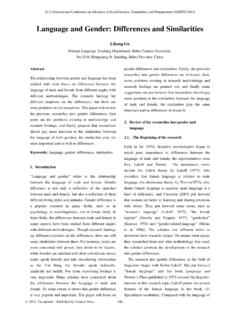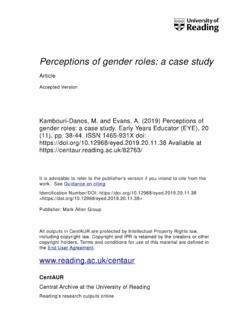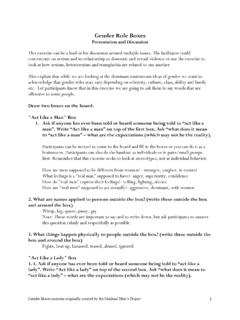Transcription of Guidelines for gender mainstreaming in project stages
1 Guidelines for gender mainstreaming in project stages (Identification, Design, Implementation, Evaluation / Monitoring) Contents Objectives of gender mainstreaming in projects .. 2 mainstreaming in different project stages .. 2 project Checklist for gender mainstreaming .. 6 project Data .. 6 gender Budgeting in the project .. 8 2 Objectives of gender mainstreaming in projects The overall objective of mainstreaming gender within projects is to have a gender sensitive project that provides a signal that helps to measure gender -related changes in the society, politics, economic participation etc. gender mainstreaming in projects is about using participatory approached in all project stages . The initial step is to have a basic understanding of what gender mainstreaming is It is ensuring that strategies and actions for ending discrimination at all levels and stages of the project cycle; taking into consideration men and women s needs, desires, ambitions when decisions are made and resources are allocated All projects begin with the same basic questions: What are the practical implications of the different roles and status of women and men in the project area?
2 How will these affect the chance of the project being successful? How will these affect the project design? If roles are rigidly divided by gender and this division is strictly enforced by law or custom, a project to expand the activities of women into male- only areas is likely to fail. Your first task is to figure out what can and cannot be accomplished in a particular area. On the other hand, much can be done to improve women s and men s lives even within separate spheres. What is the strategic potential of the project for improving the status of women and promoting gender equity? How will the project affect women and men? How can the project contribute to long-term strategies to achieve gender equity? A project aimed at improving women s abilities and facilities for doing their reproductive and productive roles could improve the physical well-being of the entire community.
3 If the project includes ways of celebrating and rewarding women s efforts, their contributions to the community become more visible and valued - which increases women s status in general. mainstreaming in different project stages project stage How to mainstream Identification The purpose of this stage is to show how the situation as it exists at the beginning of the project , before starting activities that target change. Identify and define the general purpose and objectives of the project . What are the objectives of the project ? (For example: empowering women financially ; improving gender relations ; improving public knowledge of gender factors in HIV/AIDS transmission ) Who are the target beneficiaries? Are women s practical and/or strategic needs a specific focus of the project ? 3 What, if any, are the anticipated benefits for women (skill development, increased productivity, income opportunities etc)?
4 Can a gender -inclusive design be drawn up for the project , and the project still effectively target women? Have there been any earlier efforts with the same objectives? With what success? Identify and assess gender needs and opportunities What is the gender division of labour in general in the region? What are the main sources of income for women and for men? What needs and opportunities exist for increasing women s productivity and/or production? To what degree are women visible in the target sector (such as farming, telecommunications, fishing, and housing)? Are women s needs in the sector the same as those of men? Have both men and women been consulted in identifying needs and opportunities related to the general purpose of the project ? Do women and men have equal access to resources? If not, what opportunities exist for increasing women s access to and control of resources and/or benefits?
5 Identify possible negative effects Is the project likely to have same positive and negative effects on women and on men? Might the project , in general, reduce women s access to or control of some resources or benefits they currently have? Does the organisation, institution or task group responsible for doing the project (the implementing agency) have the capacity and authority to deliver benefits to women or to involve women? What social, economic and political effects will the project have on women and on men in the short term? In the longer term? Design and Planning The purpose is to determine the specific activities of the project project Analysis and Design Is information on household economic arrangements (such as roles; sex/age/time of labour; land ownership/control; sources/types/control of incomes) adequate for the planning and evaluation of project ?
6 4 Are there legal, cultural, religious or other constraints on women s potential participation in the project ? Have strategies been formulated to address these factors? How are men s and women s activities, access to and control of resources shaped by structural factors (legal, customary, institutional)? Will women directly benefit from all project components? Does the project design include strategies to facilitate women s active involvement in the project ? Define objectives in terms of outputs and deliverables Are project objectives clearly related to practical and strategic gender needs? Have both men and women participated in setting those objectives? Which activity or activities (production, reproduction, socio-political) does the project involve? Do women and men view the planned activity in the same way? o (For example: A project wants to streamline engagement and women s participation in mainstream civil society issues.)
7 Do the women, men and the project all have the same viewpoint about the time that can be spared for engagement and participation, the priority this activity should have, who should keep the profits and what resources should be used for?) What specific changes are planned in the target sector or activity? To change the location of the activity? To change the mode of activity (means or methods of production)? The technology involved? To introduce new products or enterprises? What positive or negative effects would there be on women and on men of such changes? What measurable product or output will be produced? Policy issues How will men and women participate in the project , and in what capacities? Which government agencies and NGOs with a focus on women (or an interest in gender and development) might contribute to the project - financially or with expertise?
8 Are the regulatory policies that will affect what can or cannot be done in the project and/or how it must done? Have local women s organisations been consulted? 5 Budgeting Is there budgetary allocation for all design features, strategies and mechanisms in the project ? Will there be a separate budget (or line-item budget) for facilitating the participation of women? Is the level of funding enough to complete the planned tasks? Is it possible to track funds for women and men separately - from allocation to delivery - with a fair degree of accuracy? project Implementation Putting the project plan into action How will the following be achieved and who will be responsible for each area? Staffing: scheduling, procedures, training, Managing: organisational structures, on-site work Logistics and operations, ordering and delivery of necessary materials Finances: bookkeeping, fundraising, liaise with donor organisations How will various aspects of the project be co-ordinated?
9 And by whom? Are there appropriate opportunities for both women and men to participate in project management positions? Are there mechanisms to ensure that the project resources or benefits are not controlled or taken over by males? Or by sub-groups, factions or individuals within / outside the community? How will disagreements and disputes be handled and by whom? Is every person on the project trained in gender - mainstreaming ? If not, will this happen before activity begins? Evaluation and Monitoring Are you progressing toward the project goal the way you had intended? What methods of monitoring and evaluating the project (quantitative and qualitative) have been established? (How will you know whether you are meeting your project goals? What will you measure and how will you do this?) Are women involved in the monitoring and evaluation? What indicators are there to measure progress in achieving goals and benefits?
10 Is data collected often enough so that adjustments can be made during the project ? Is the data fed back to the project personnel and to the community in an understandable form and on a timely basis, so that adjustments can be made? 6 Are there separate indicators to measure progress in achieving benefits for women and men? project Checklist for gender mainstreaming Key Issues Representation of women versus men Activities carried out by men and women Key Strategies Support of project female beneficiaries (these can include women s organisations) Reflections on reciprocity and cooperation between men and women Ensure that new technologies and systems designed are accessible to women Does the project encourage collaboration between men s groups and women s groups? Does the project seek collaboration from formal women s groups? Design of infrastructure, policies, advocacy strategies Does the design of advocacy strategies empower women equally as men?











